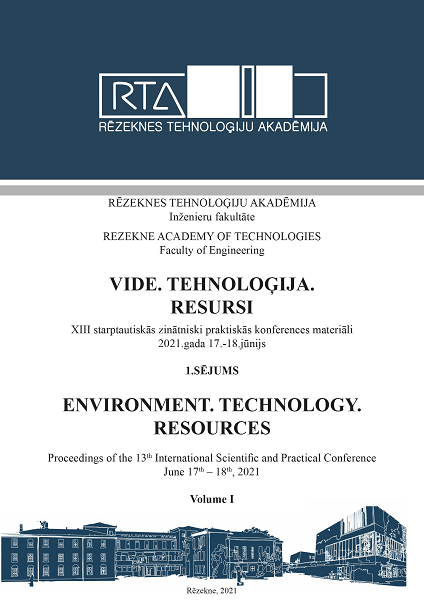MECHANICAL PROPERTIES OF WOOD PLASTIC COMPOSITES WITH THE ACTIVATED WOOD FILLER
DOI:
https://doi.org/10.17770/etr2021vol1.6584Keywords:
mechanical properties, recycled polypropylene, wood-plastic composite, wood surface activationAbstract
The aim of the research was a study of the effect of activation of birch sawdust microparticles with a dilute solution of sodium hydroxide at a low temperature on mechanical properties and water sorption of the obtained wood plastic composite (WPC) samples obtained from a by-product of a domestic wood mechanical processing and a recycled polymer municipal waste. It was found that the mechanical (tensile, bending) properties of the WPC samples filled with the activated birch sawdust microparticles were higher than those of the samples filled with the initial sawdust. The sorption and swelling degree of the WPC samples with the activated filler were lower than those for the samples with the initial sawdust. However, the difference in the values of the water sorption and the swelling degree for the samples filled with the activated and initial wood microparticles were relatively low in comparison with the observed essential difference in their mechanical properties. This fact was explained by the enhanced content of carbonyl groups in the activated sawdust microparticles that are able to absorb water.
Downloads
References
K. L. Pickering, M. A. Efendy, T. M. Le, A review of recent developments in natural fibre composites and their mechanical performance, Compos. Part A- Appl. S., 2016, 83, pp. 98-112.
O. Faruk, A. K. Bledzki, H.-P. Fink, M. Sain, Biocomposites reinforced with natural fibers: 2000-2010, Prog. Polym. Sci., 2012, 201237(11), pp. 1552-1596.
J. Korhonen, A. Honkasalo, J. Seppälä, Circular economy: The concept and its limitations, Ecol. Econ. 2018, 143, 37-46.
M. Farsi, Effect of surface modification on thermo-mechanical behaviour of wood-polymer composite, Asian J. Chem., 2012), 24(6), pp. 2775-2779.
K. L. Pickering, M. A. Efendy, T. M. Le, A review of recent developments in natural fibre composites and their mechanical performance, Compos. Part A- Appl. S., 2016, 83, pp. 98-112.
M. J. John, R. D. Anandjiwala, Recent developments in chemical modification and characterization of natural fibre-reinforced composites, Polymer Composites, 2008, 29(2), pp. 187-194.
K.G. Satyanarayana, G.G.C. Arizaga, F. Wypych, Biodegradable composites based on lignocellulosic fibers, An overview, Progress in Polymer Science, 2009, 34, pp. 982 -998.
G. Shulga, B. Neiberte, A. Verovkins, S. Vitolina, J. Jaunslavietis, J. Ozolins, Short fibre filler from wood residue for polymeric composite materials, Mater. Sci. (Medžiagotyra), 2016, 22(3), pp. 370-375.
X. Li, L.G. Tabil, S. Panigrahi, Chemical treatments of natural fiber for use in natural fiber–reinforced composites, Journal of Polymers and the Environment, 2007, 15, pp. 25-28.
J. Lin, Z. Yang, X. Hu, G. Hong, S. Zhang, Wei Song, The Effect of Alkali Treatment on Properties of Dopamine Modification of Bamboo Fiber/Polylactic Acid Composites, Polymers, 2018, 10, pp.1-12.
G. Rajesh, AVR. Prasad, Effect of fibre loading and successive alkali treatments on Tensile properties of short jute fibre reinforced polypropylene composites. Advanced Materials Manufacturing and Characterization, 2013, 3, pp. 528-535.
TAPPI T203 cm-99 (1999). “Alpha-, beta- and gamma-cellulose in pulp,” TAPPI Press, Atlanta, GA, USA.
TAPPI T222 om-02 (2002). “Acid-insoluble lignin in wood and pulp,” TAPPI Press, Atlanta, A, USA.
TAPPI T264 om-97 (1997). “Preparation of wood for chemical analysis,” TAPPI Press, Atlanta, GA, USA.
R. M. Taib, Z. A. M. Ishak , H. D. Rozman, W. G., Glasser, Effect of moisture absorption on the tensile properties of steam-exploded Acacia mangium fiber-polypropylene composites, J. Thermoplast. Compos. Mater., 2006, 19(5), pp. 475-489.
A. Fortini, V. Mazzanti, Combined effect of water uptake and temperature on wood polymer composites: Research Article. J. of Applied Polymer Science, 2018, 135(5): 46674, pp. 1-9.


